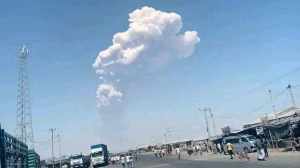Three-day survey on dragonflies begins at seven biodiversity parks in the Capital
The students, part of a group carrying out a three-day survey, are counting the number of dragonflies and damselflies across the seven DDA biodiversity parks in Delhi. The annual exercise began on Thursday. The survey was earlier held in 2018, 2022, 2023 and 2024.
 According to experts, in Delhi, the insects can control cases of dengue as they feed on mosquitoes. (Express)
According to experts, in Delhi, the insects can control cases of dengue as they feed on mosquitoes. (Express)A steep, rugged trail leads one to the Chauburja mosque, an ASI-protected 14th-century site in the Kamla Nehru Ridge. A group of students from DU’s Shyama Prasad Mukherji College for Women catches sight of a swarm of yellowish-orange Wandering Gliders. Eight dragonflies perch on a branch, soaking in the sun.
The students, part of a group carrying out a three-day survey, are counting the number of dragonflies and damselflies across the seven DDA biodiversity parks in Delhi. The annual exercise began on Thursday. The survey was earlier held in 2018, 2022, 2023 and 2024.
“Dragonflies and damselflies are totally dependent on wetlands. Seasonal water bodies in Kamla Nehru Ridge and perennial water bodies at Yamuna Biodiversity Park are the microhabitats for them to thrive,” said entomologist Mohammad Faisal.
Pointing at the flood-like situation that the Capital witnessed this monsoon, he said, “Flood impacts the ecology and brings a change in the species present in an area. We expect sightings of new species in this geographic area…these can come from upstream of rivers from areas such as Panipat, Sahranpur, Dehradun.”
He added that only the final count could give the exact picture.
“These insects, vital bioindicators of ecosystem health, rely on clean water and diverse habitats for their breeding and larval stages.They play a vital role in the ecosystem as both predators and prey. As predators, they feed on mosquitoes and other small insects, thus helping control pests and safeguard human health. As prey, they support birds, frogs, and other wildlife, forming an essential link in the food web. Their presence and diversity are therefore indicators of healthy aquatic and terrestrial ecosystems,” said Dr Ekta Khurana, Scientist Incharge, Kamla Nehru Ridge
Meanwhile, at the ridge, Dr Arjun, the supervisor of a Centre for Environmental Management of Degraded Ecosystems (CEMDE) programme at the park, led another group of 50 students through marshes and a serpentine lake. Talking about the impact of climate change on the dragonfly population, he said, “A rise in the temperatures affect their population. If it doesn’t rain enough, mosquitoes won’t be enough, and thus the balance is affected.”
Around 15-20 days ago, he said, a sudden surge in the population of the insects was observed with the rise in the level in water bodies, an increase in muddy spaces and marshy areas. The insects significantly control the population of disease-causing pathogens and mosquitos, he said.
As the students carry out the survey, he asks them to look for dry branches, shady, low-lying areas and places with good undergrowth where ground flora acts as a good hiding spot.
Ilma Naaz, a second-year zoology student at Ramjas, said, “I didn’t know there were these diverse species of dragonflies. Its importance is also very little talked about… unless we actually see their role on the ground, we fail to value them.”
“The restoration of Kamla Nehru Ridge has transformed this degraded and altered landscape into a model of ecological revival. It strategises hydrological recovery, by channelising water, restoring natural drainage patterns and restoring ephemerals and perennial water bodies… Together, these efforts have helped create multiple microhabitats such as shallow pools, marshy fringes, and shaded forest edges, which are crucial for sustaining dragonflies and damselflies,” added Khurana.
Last year’s survey highlighted that the diversity of dragonflies and damselflies species decreased across parks, with the Kamla Nehru Ridge having recorded a maximum count of 3,150. The number has significantly increased from last year’s count.
Experts also explained that in the context of Delhi, the insects are critical to control the cases of dengue that is on the rise.
Globally, the species have remained under threat. The loss of wetland ecosystems, marshes and swamps due to human impacts on habitats, invasive alien species, increasing droughts due to climate change, excavation of river beds, and pollution have led to a sharp decline in their number.
The International Union for the Conservation of Nature, in its global assessment in 2021, found that 16% of 6,016 species of dragonflies and damselflies are at risk of extinction, with their freshwater breeding grounds having plummeted.







